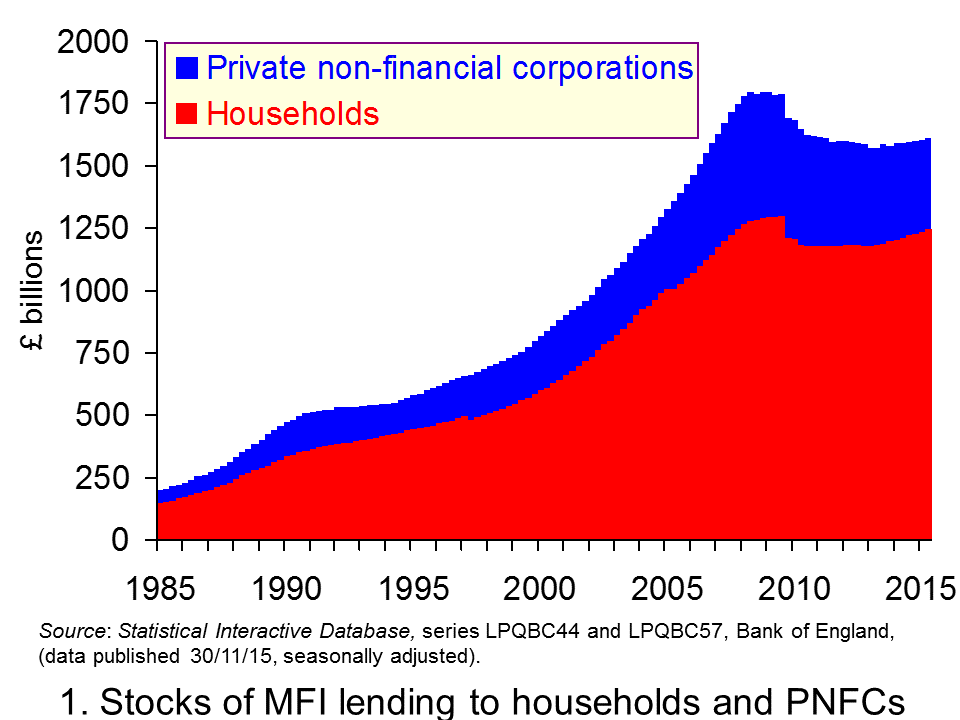Is Minsky right yet again?
 To what extent does history repeat itself? Minsky’s Financial Instability Hypothesis infers that credit cycles are fairly inevitable. We have seem them in the past and we will see them in the future. Human beings are subject to emotion, to irrational exuberance and to a large dose of forgetfulness! To what extent do the latest UK credit numbers suggest that we might be embarking on another credit binge? Are the credit data consistent with evidence of another credit cycle?
To what extent does history repeat itself? Minsky’s Financial Instability Hypothesis infers that credit cycles are fairly inevitable. We have seem them in the past and we will see them in the future. Human beings are subject to emotion, to irrational exuberance and to a large dose of forgetfulness! To what extent do the latest UK credit numbers suggest that we might be embarking on another credit binge? Are the credit data consistent with evidence of another credit cycle?
 Chart 1 shows the stocks of debt acquired by households and private non-financial corporations from MFIs (Monetary Financial Institutions). The scale of debt accumulation in the late 1980s and again from the mid 1990s up to the financial crisis of the late 2000s is stark. At the start of 1985 the UK household sector had debts to MFIs of around £140 billion. By the start of 2009 this had hit £1.29 trillion. Meanwhile, private non-financial corporations saw their debts to MFIs rise from around £45 billion to over £500 billion. (Click here to download a PowerPoint of the chart.)
Chart 1 shows the stocks of debt acquired by households and private non-financial corporations from MFIs (Monetary Financial Institutions). The scale of debt accumulation in the late 1980s and again from the mid 1990s up to the financial crisis of the late 2000s is stark. At the start of 1985 the UK household sector had debts to MFIs of around £140 billion. By the start of 2009 this had hit £1.29 trillion. Meanwhile, private non-financial corporations saw their debts to MFIs rise from around £45 billion to over £500 billion. (Click here to download a PowerPoint of the chart.)
The path of debt at the start of the 2010s is consistent with a story of consolidation. Financially-distressed households, private non-financial corporations and, of course, MFIs themselves meant that corrective action was needed to repair their balance sheets. The demand for and supply of additional credit waned. Debt accumulation largely ceased and, in fact, debt numbers fell. This trend continues today for private non-financial corporations. But, for households debt accumulation resumed in the middle of 2013. At the end of the third quarter of 2015 the household sector had debt obligations to MFIs of £1.246 trillion.
 Chart 2 focuses on flows rather stocks. It allows us to see the accumulation of new credit (i.e. less repayments of debt). What is even more apparent from this chart is the evidence of cycles in credit. The growth in new credit during the 2000s is stark as is the subsequent squeeze on credit that followed.
Chart 2 focuses on flows rather stocks. It allows us to see the accumulation of new credit (i.e. less repayments of debt). What is even more apparent from this chart is the evidence of cycles in credit. The growth in new credit during the 2000s is stark as is the subsequent squeeze on credit that followed.
The question that follows is what path are we now on? Clearly flows of credit to households are again on the rise. In part, this is driven by the rebound in the UK housing market. But, in fact there is a more rapid increase in consumer credit, i.e. unsecured debt. (Click here to download a PowerPoint of the chart.)
 Chart 3 shows the flows of consumer credit from MFIs and other credit providers. Again, we see the marked evidence of cycles. In the year to the end of Q1 of 2015 net consumer credit flows amounted to £22.8 billion, the highest figure since the 12-month period up to the end of Q3 of 2005. Click here to download a PowerPoint of the chart.)
Chart 3 shows the flows of consumer credit from MFIs and other credit providers. Again, we see the marked evidence of cycles. In the year to the end of Q1 of 2015 net consumer credit flows amounted to £22.8 billion, the highest figure since the 12-month period up to the end of Q3 of 2005. Click here to download a PowerPoint of the chart.)
While it might be a little early to say that another Minsky cycle is well under way, policymakers will be keeping a keen eye on credit patterns. Is history repeating itself?
Articles
Average UK mortgage debt rises to £85,000 The Guardian, Phillip Inman (15/12/15)
Consumer spending rise troubles Bank of England The Guardian, Heather Stewart (24/11/15)
Recovery ‘too reliant on consumer debt’ as BCC downgrades forecast The Guardian, Heather Stewart (9/12/15)
BCC: UK Growth Too Reliant On Consumer Debt Sky News (9/12/15)
Interest rates will stay low for longer – but household debt is a worry, says BoE The Telegraph, Szu Ping Chan (24/11/15)
IMF: UK’s economic performance ‘very strong’, but risks remain BBC News (11/12/15)
Data
Bankstats (Monetary and Financial Statistics) – Latest Tables Bank of England
Statistical Interactive Database Bank of England
Questions
- How can the financial system affect the economy’s business cycle?
- What does it mean if households or firms are financially distressed? What responses might they take to this distress and what might the economic consequences be?
- How would you measure the net worth (or wealth) of an individual or a firm? What factors might affect their net worth?
- How might uncertainty affect spending and saving by households and businesses?
- What does it mean if bank lending is pro-cyclical?
- Why might lending be pro-cyclical?
- Are there measures that policymakers can take to reduce the likelihood that flows of credit become too excessive?